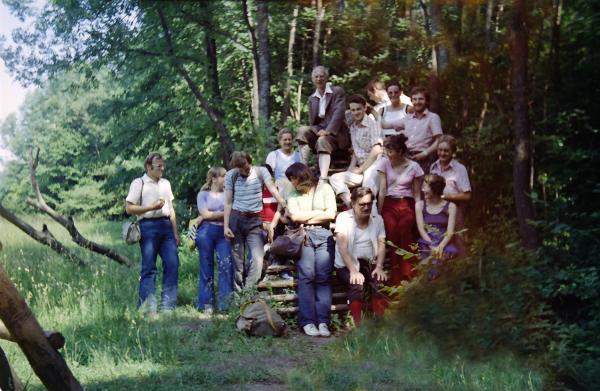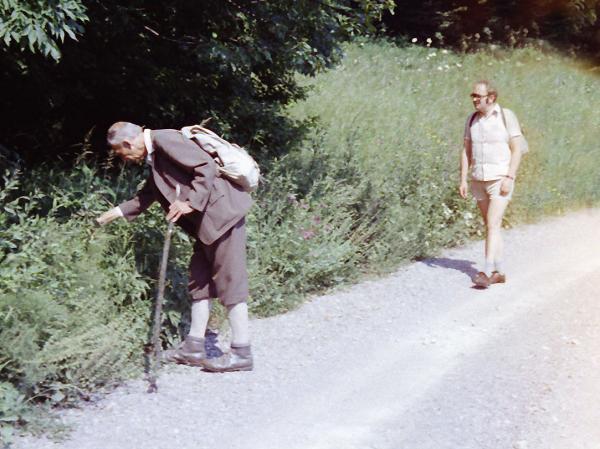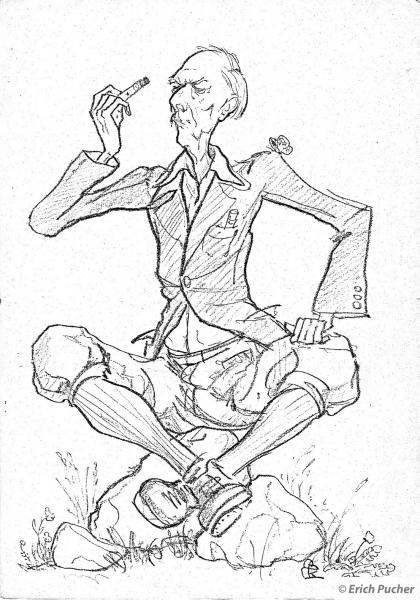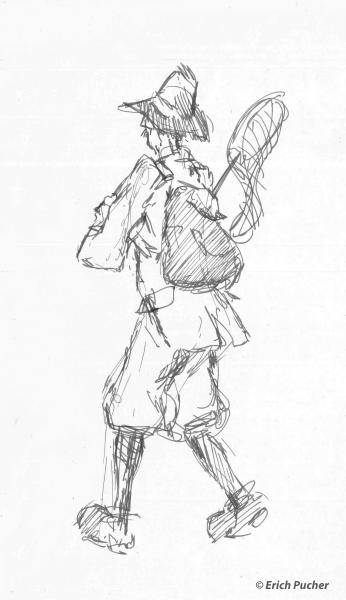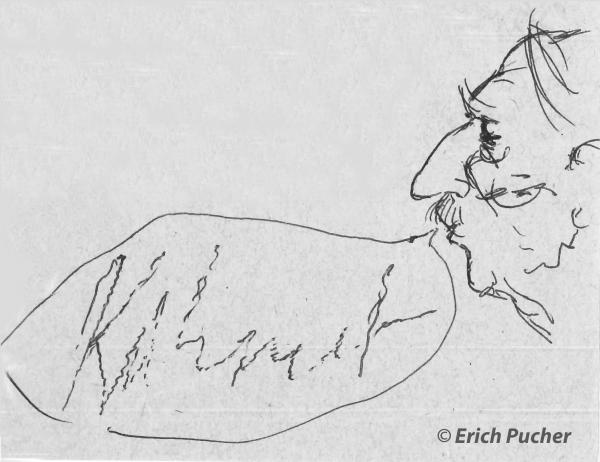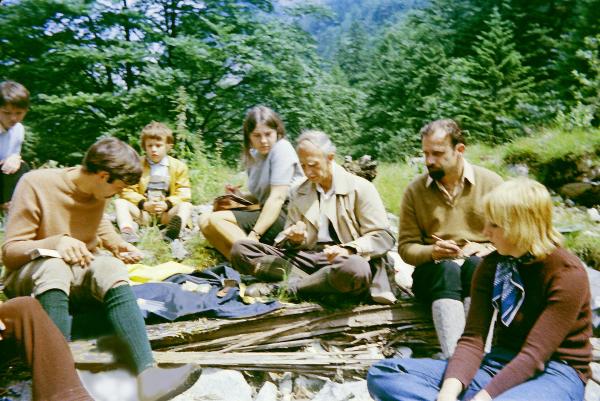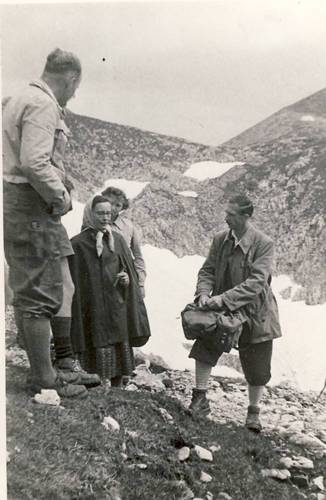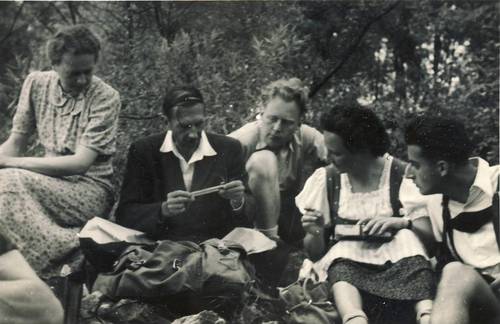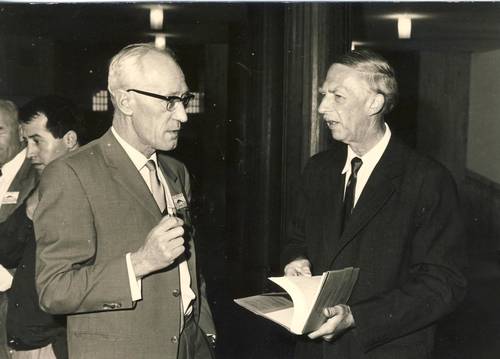Univ.-Prof. Dr. phil. Wilhelm Kühnelt
# Entom.;
Tiergruppen: Alle, besonders Insecta und Mollusca; Bodenbiologie, am meisten interessierten ihn Heuschrecken und Käfer, bevorzugt Tenebrioniden.
Biographie zusammengefasst in KREISSL, FRANTZ & GEPP 2002 (mit Portrait). Nekrologe und Literatur: CHRISTIAN 19.. ; - KREISSL: persönliche Erinnerungen; - SCHALLER 1988; - KÜHNELT 1932... zahlreiche Publikationen bis 1984.
geb. 1905 (Linz). Vorwiegend tätig in Wien und Graz.
ASPÖCK H. (1980): mit Veröff.-Verzeichnis (4 Zitate v. 1943-1975) Neuropteren betreffend.
geb. 1905, gest. 1988. Ordinarius in Graz. Betreffend Aktivitäten am Inst. für Zoologie der Univ. Wien siehe SALVINI-PLAWEN & MIZZARO 1999.
geb. 1905, gest. 1988; Vorstand des 2. Zoologischen Instituts der Universität Wien. Biographie: FRANZ, H., 1988: Almanach der Österr. Akad. Wiss. 138: 317-328; SCHALLER, F., 1989: Z. ArbGem. Öst. Ent. 40: 126.
Er studierte an der Universität Wien 1923-1927 naturwissenschaftliche Fächer, besonders Zoologie, Botanik und Chemie, promoviert 1927, Lehramtsprüfung 1928 und 1934 habilitiert; er war Assistent am 2. Zoologischen Institut der Universität Wien, als Kriegsgefangener 2 Jahre in den USA, wo er schon Freilandzoologie betrieb; 1950 wur-de er zum außerordentlichen Professor mit dem Titel eines ordentlichen Professors und Vorstandes des Zoologischen Institutes der Universität Graz ernannt; 1953 an die zoo-logische Lehrkanzel in Wien bis emeritierung 1975. 1955 wurde er korrespondierendes, 1959 wirkliches Mitglied der Öst. Akademie der Wiss.; Obmann der Akademie Kom-mission für Ökologie; Mitglied der zoolog.-bot. Gesellschaft seit 1926 und Vizepräsi-dent von 1959 bis zu seinem Tod.
145 Veröff. (1928-1985), u.a. die Tierwelt des Burgenlandes, die Landtierwelt mit besonderer Berücksichtigung des Lunzer Gebietes, die Veränderungen der heimischen Tierwelt in jüngster Vergangenheit, die Tierwelt der Steiermark, die Insektenwelt Österreichs in ökologischer Betrachtung, die Verteilung der Tierwelt in Österreich, die Tierwelt der Alpen und ihre Veränderungen in geschichtlicher Zeit, etc. Pionier der terrestrischen Ökologie und als solcher Begründer der Bodenzoologie.
1950 erschien sein Buch "Bodenbiologie", das zwei Auflagen erlebte und auch in die spanische und englische Sprache übersetzt wurde, 1965 veröffentlichte er das Buch "Grundriß der Ökologie", das auch ins Französische übersetzt wurde.
FRANZ, H. 1987/88: Wilhelm Kühnelt. - Österr. Akad. d. Wiss. Almanach 138: 316-328 (mit Porträt und Publikationsliste).
KLAUSNITZER, B., 1989: Wilhelm Kühnelt (1905-1988) zum Gedenken. - Pedobiologia, 33: 373-378.
SCHALLER, F., 1989: Univ. Prof. Dr. Wilhelm Kühnelt 28.7.1905 - 5.4.1988. - Z. ArbGem. öst. Ent., (1988) 40(3/4): 126.
geb. 1905, gest. 1987
Erwähnung in SCHALLER 2002 als Bodenarthropoden-Kundler Österreichs (mit Porträt).
SCHALLER, F., 1988: Univ.-Prof. Dr. Wilhelm Kühnelt zum Gedenken (28.07.1905-05.04.1988). - Verh. Zool.-Bot. Ges. Ö. 125: 139-142 (mit Porträt).
Wilhelm Kühnelt (1905-1988) - Scientist and Teacher
A memory on occasion of his hundredth anniversary
compiled by his former assistants
Friedrich Schaller, Heinz Löffler, Reinhart Schuster, Erwin Führer, Herbert Nopp, Kurt Pohlhammer, Karl Sänger, Benno Darnhofer, Helmut Pruscha, Wolfgang Waitzbauer and Gerhard Spitzer
2005 marks the hundredth jubilee of Wilhelm Kühnelt and suggests to recall his scientific merits concerning general and especially terrestrial ecology and to remember him as a leading teacher of these fields at the University of Vienna. Our group trying to take this challenge consists of Kühnelts still living employees presented in temporal order during his periods as assistant and professor.
Schaller F., Löffler H., Schuster R., Führer E., Nopp H., Pohlhammer K., Sänger K., Darnhofer B., Pruscha H., Waitzbauer W. und Spitzer G., 2005: Wilhelm Kühnelt (1905-1988), Wissenschafter und Lehrer. Zum Gedenken an den 100. Geburtstag, zusammengestellt von seinen ehemaligen Assistenten.
Wilhelm Kühnelt, an den Universitäten in Wien und in Graz tätig, war Zoologe und führend in Wissenschaft und Lehre im Bereich der terrestrischen Ökologie.
W. Kühnelt was born in Linz about 40 years after Ernst Haeckel (1866) who quoted any kinds of relationship between all existing organisms and the biosphere of our planet (Eduard Suess 1875) as the science of ecology.
His studies at the Vienna University (1923-1927) were devoted to zoology, botany and - not so usual at that time for biologists - to chemistry. He obtained the doctor's degree in July 1927 and in addition passed the examinations for permission to teach at high schools natural history and chemistry. During his undergraduated time he found excellent support and stimulation by well-known scientists such as B. Hatschek (important work on Amphioxus and former student of E. Haeckel), K. Grobben (who proposed Proto- and Deuterostomia), J. Versluys (comp. anatomy of vertebrates), L. Bertalanffy and K. Przibram (theoretical biology and physiology), O. Storch (micro-kinematography), F. Ruttner (limnology) and the pedologists W. Kubiena and H. Franz.
Moreover, the German physiologist P. Krüger who stayed at the Vienna University for only 4 years after Kühnelt's graduation established a laboratory course in animal ecology and physiology which was taken over by Kühnelt after his habilitation (1934).
Apart of never ending scientific inquisitiveness, the influences mentioned are reflected by an imposing diversity of research subjects already during his undergraduate period and his assistantship until his habilitation. They comprise (bio-) chemical, anatomical-morphological and, obviously stimulated by the famous palaeontologist O. Abel, paleoecological studies (such as his piddock investigations) and concern mainly insects and molluscs. But already at the beginning of his scientific activity (1928-1934) several ecological publications such as "microclimate and terrestrial fauna" show his later predominant interest. Apart from ecotones (snow-line of high mountains and littoral of rivers, lakes and the sea) some of his favourite localities were Lunz and the Neusiedler See area and remained so for a long time. Among his total of approximately 200 papers including books quite a number is devoted to important theoretical considerations such as "principles of systematics" (1940) and the "Leitformen"-method in ecology of terrestrial animals, at about the same time as A. Remane performed his work on life-form types (1943).
In 1943 Kühnelt was drawn into military and after imprisonment in the United States (where to some extent he could carry out field research) he eventually returned to Vienna in 1946. 1947 he was invited to carry on with his teaching activities and at the same time he intensified - stimulated by W. Kubiena - his work in soil ecology. As a result of all this efforts he could present his "Soil Biology", indeed the work of a professional pioneer. 1957 it was translated into Spanish and twice (1961 and 1967) into English. It should be stressed that several details and results are derived from his students and colleagues (e.g. J. Donner, H. Franz, W. Kubiena etc.).
However, it must be stated at this occasion, that his taxonomic knowledge especially of invertebrates was legendary especially culminating in certain Coleoptera such as tenebrionids and chrysomelids but also Orthoptera and many soil dwelling groups. That did not exclude his interest in vertebrates as demonstrated by relevant ecological, physiological (e.g. A remarkable case of longevity in Palmatogecko rangei 1982) and biogeographical work or support of a thesis on biology of the bearded titmouse (Panurus biarmicus) by G. Spitzer. His retentiveness was certainly widely recognized.
1950 he was offered the chair for zoology in Graz and succeeded the later Nobel Prize winner K. V. Frisch. He introduced the fields of ecology, ecological geography and his "principles of systematic". One of his students (L. Dölling) was stimulated to study together with Kühnelt the destruction of leaves in aquatic environment, a process which results in POM (particulate organic matter), an important factor in mainly running waters as recognized during later programs such as the IBP. In addition one of our authorteam, R. Schuster was invited to work on the decomposition processes in soil by oribatids. The co-writer of this article is now an emeritus of the University of Graz. 1952 Kühnelt worked for several weeks in the "Instituto de Edafologia y Fisiogia Vegetal" in Madrid and returned finally to Vienna, still during 1953. There he stayed as the head of the so called II. Zoological Institute until the zoological departments (I., W. Marinelli and II) in need of more space were after several political scandals shifted to an uttermost unsuitable location far from many other relevant science departments in 1982. In spite of these conditions Kühnelt had to accept an emeritus room offered to him by W. Waitzbauer (H. Nopp, G. Spitzer).
He became soon also active in the Austrian Academy of Sciences when elected as corresponding member in 1955 and only 4 years later as an ordinary one. As chairman of commissions such as the "exploration of Neusiedler See" and "the fauna of Austria" (1959-1988) he could contribute to the development and progress of many projects.
During his now culminating period of 12 years he concentrated more than ever before on ecological geography (Austria, Spain, Greece etc.) and on integrated biomes such as the mountains (Alps and Pyrenees), cities (restricted mainly to Vienna) and riverine landscapes, leaving the inland waters to the fast growing limnological schools. In addition, numerous ecosystems such as caves were carefully studied. Therefore it did not appear as a surprise that after this period between 1953 and the early sixtieth his "Grundriss der Ökologie" was published in 1965 (402 pp.). The high quality of this book is based on Kühnelts excellent observations and analyses of biocoenoses and ecosystems of the terrestrial biomes and the problem of life-form types to which he consecrated 50 pages. A second edition (1970, 443 pp.) gave him the opportunity to include the experiences from his Namibia excursion and a French translation gave this book a wider distribution. With his monography of the genus Chrysochloa (chrysomelids, leaf beetles) he produced his last comprehensive paper which again demonstrated one of his systematic preferences.
During the years to follow Kühnelt increasingly became concerned about environment risks and changes such as immigration and extinction cases of animals. Already when in a discussion of Kühnelt with his colleague Prof Dr. Gertrud Pleskot in broadcast the publicity was informed in January 1971 about ecology both speakers stressed the negative influences of civilization and changes of the environment. Probably the projects of atomic power plants may have been the releasing motivation for these remarks.
His efforts for protecting and saving valuable environment and better understanding of it and improved handling became honoured after his decease by the establishment of a "Wilhelm Kühnelt Seminar".
As a University teacher for animal ecology and physiology, animal biogeography and taxonomy Kühnelt was most welcome (again) in Vienna and in Graz. His clear and well understood lectures in which he stressed and emphasized important matters and connections and in addition gave an astonishing large amount of examples and case studies were attentively received. He also informed about modern soil ecology and stimulated numerous students with proposed subjects and topics as choice for their thesis (e.g. E. Führer [now emeritus at the University of Agriculture] with his "relation soil arthropods and plant-roots"). One member of our publishing group still remembers when sitting together with two at present famous emeriti in Kühnelts ecology lecture (October 1947, room 42) that they whispered eagerly " ... finally something new and so well presented ..."
There is no doubt that most of his students enjoyed his lectures and practical courses (e.g. animal physiology) and likewise, if not even more, his excursions which in Vienna followed a certain order, beginning during spring with a riverine area in Vienna (e.g. the "Prater") followed by a visit of dry meadows and shrub hills near Hainburg (east of Vienna, then the area east of Neusiedler See ("Seewinkel") and localities of the SE part of Vienna Forest and finally a high-mountain site (e.g. Rax).
Later he introduced a frost-night excursion for the demonstration of Geometridae adapted to those climatic conditions (e.g. Operophtera sp., Erannis sp.). During these excursions students would collect any (mostly) invertebrates and kept them in glasstubes or -boxes and at several stops sit in a circle with Kühnelt who had been given the collected animals. Then the participants were informed about taxonomy, morphology, physiology etc on each species. Sometimes up to more than 100 species were presented during such an excursion harvest (F. Schaller).
In the memory of most of us Kühnelt was a modest (K. Sänger), rather ascetic person with a long, bony face with its mustache, a slender tenacious body, able for endless excursions.
Known to all of our group he was a rather helpful person if confronted with people concerned with problems. The most obvious example is the case of the student F. Schaller from Germany with a disabled arm and hand when he approached the young assistant Kühnelt in 1939 whether under this condition he could study zoology. Kühnelts answer was only a short request "I can't tell you now but see me after three days!" When F. Schaller appeared again he was told that he could start with zoology as the main subject. Only many years later, when F. Schaller's thesis on Collembola of the Vienna Forest (stimulated by Kühnelt) had been already printed, Kühnelt admitted that he had successfully used only one arm and hand for his own scientific work during those three days. Kühnelt was also patient with students missing any ability for rational and fast working in spite of their interest to achieve their aims. He rarely became inpatient if for example one of his assistants delayed the return from field work (letter to H. Löffler, Shiraz, 8. VII. 1956). On the other hand - as has been mentioned - he was most inquisitive, sometimes even curious (K. Pohlhammer) and at the same time manifested his unbelievable systematic knowledge when he wrote (15. VII. 1964 to H. Löffler) again: you could imagine how much I would be delighted to see once a Teinopalpus flying). Sometimes he came up with sudden questions which one had to be prepared for. Kühnelt was sensitive but mostly tolerant. During the period in the "Old University" the assistants of both Zoological Institutes (I and II, Marinelli and Kühnelt) used at least twice a year to perform a cabaret with careful rehearsals (with or without music) for which the late assistant of Kühnelt, E. Abel, was most often in charge of its preparation. Ironic remarks and imitations concerning our professors were of course obvious.
Already in 1962 Kühnelt (preparations for the 600 anniversary of the Vienna University [1365] were going on) expressed his great concern in connection with the necessity of a larger and modern building, which the zoological institutes were in need as mentioned above. He was afraid that they should be shifted to the so-called "New University" close to the main building but an ugly edifice which at the time of its planning and construction was supposed to serve for the University Library. After several political scandals "The Zoology" came finally about (as already noted) far away and close to the Economy University. The pompous title "Biocenter" (plant physiology, human biology and zoology) was given to this most inconvenient building. Moreover, the government did not hesitate to establish a second "Biocenter" on the other side of Vienna.
Our group hopes that with this short message for our colleagues we succeeded to renew the memory of Wilhelm Kühnelt. A list of his publications (including the books is presented by H. Franz (1988) in: Almanach of the Austrian Academy of Sciences 138, 320-328.
aus Schaller F., Löffler H., Schuster R., Führer E., Nopp H., Pohlhammer K., Sänger K., Darnhofer B., Pruscha H., Waitzbauer W. und Spitzer G. 2005: Wilhelm Kühnelt (1905-1988) - Verh. Zool.-Bot. Ges. Österreich 142: 87-91.
Auf eine Wiedergabe des Lebenslaufes dieses so bedeutenden Gelehrten, der vor allem als Ökologe Weltgeltung erlangte, kann an dieser Stelle verzichtet werden, denn es existieren ausführliche Nachrufe. Im Rahmen seiner Tätigkeit als Universitätsprofessor war KÜHNELT von 1950-1953 als Vorstand des Zoologischen Institutes der Universität Graz tätig und konnte sich in dieser Zeit intensiver als schon vorher auch mit landeskundlich-zoologischen Fragen beschäftigen.
Faunistische Leistungen: Unter KÜHNELTs Veröffentlichungen dominieren ökologische Arbeiten. Er hat jedoch auch ausgesprochen faunistische Arbeiten verfasst, und zwar nicht nur als Beiträge zur Kenntnis der Tierwelt Österreichs, sondern auch anderer Länder.
Wenn man zunächst jene Arbeiten betrachtet, die die heimische Fauna betreffen, zeigt sich, dass KÜHNELT vor allem zur Kenntnis der Tierwelt von Niederösterreich (inkl. Wien) und des Burgenlandes, aber auch zur Fauna Kärntens viel veröffentlicht hat (so beispielsweise 1939, 1948a, 1948b, 1953a, 1953b). Obwohl in diesen Veröffentlichungen keine Daten für die Steiermark enthalten sind, sind sie indirekt auch für die heimische Fauna von Bedeutung, besonders wenn Gebiete nahe der Landesgrenzen behandelt werden (wie beispielsweise das Gebiet um Lunz oder der Lungau).
Die Fauna der Steiermark wird nur in relativ wenigen Veröffentlichungen KÜHNELTs behandelt - dies in einigen spezifischen Arbeiten (1962, 1964a, 1973) und in etlichen geographisch weiter gefassten Publikationen, in denen sich auch faunistische Daten für die Steiermark finden (so 1960b, 1960c) und schließlich auch in biologischen oder taxonomischen Arbeiten (1937, 1941a, 1984). Besonders KÜHNELTs Fundpunkt-Darstellungen der Verbreitung charakteristischer Tiere im "Atlas der Steiermark" und in seinen anderen Publikationen waren auch die Grundlage für eine ganze Reihe von (umgezeichneten) Detailkarten im Band "Katalog publizierter Verbreitungskarten steirischer Tiere" (GEPP, ZORN & BAUMANN 1988).
Bei dem engen Zusammenhang zwischen Ökologie und Faunistik bzw. Tiergeographie haben auch jene Veröffentlichungen KÜHNELTs landeskundliche Bedeutung, in denen zwar keine faunistischen Daten aus der Steiermark enthalten sind, deren Inhalt aber doch auch für die Faunistik von Bedeutung ist; Beispiele dafür sind seine Veröffentlichungen 1932, 1933, 1943, 1951, 1955, 1957 usw.
Zur Kenntnis der Tierwelt der Steiermark hat Prof. KÜHNELT auch durch seine eigenen Aufsammlungen im Land beigetragen; seine Sammlung befindet sich heute im Naturhistorischen Museum Wien.
Eine sehr nachhaltige Leistung KÜHNELTs für die Steiermark bestand nicht zuletzt darin, dass er der Bodenbiologie hier wieder einen gebührenden Platz schuf und Mitarbeiter fand, die diese Richtung mit großem Erfolg weiter betrieben. Auch war Prof. KÜHNELT trotz seiner Arbeitsüberlastung immer zu Bestimmungshilfen bereit.
Bei den Coleopteren galt sein Interesse vor allem den Schwarzkäfern (Tenebrionidae); diese in der heimischen Tierwelt nicht sehr umfangreiche Familie interessierte KÜHNELT weltweit; besonders aus den Mittelmeerländern übernahm er immer gerne Tiere dieser Gruppe zur Bearbeitung.
Von KÜHNELTs Veröffentlichungen über die Fauna anderer Länder sind beispielsweise zu nennen: Seine Erfassung der Tenebrioniden im "Catalogus Faunae Graeciae" (1964b) (ein Muster für eine Faunenbearbeitung in knapper Katalogform), seine Bearbeitung der Tenebrioniden Irans (1957), die von ihm veröffentlichten (1941b) Ergebnisse einer Forschungsfahrt von Zoologen nach Zante (heute Zakynthos) und seine Beiträge zur Kenntnis der Fauna Spaniens (1954, 1960a).
In seinen Grazer Jahren nahm KÜHNELT an den regionalen Entomologentreffen u. dgl. immer als ebenso interessierter wie im positiven Sinn kritischer Zuhörer, aber auch als Vortragender teil; auch dies hatte ebenfalls spürbare Auswirkungen in der faunistischen Erforschung der Steiermark.
Literatur: CHRISTIAN 19.. ; KREISSL: persönliche Erinnerungen; SCHALLER, F. 1988: Univ. Prof. Dr. Wilhelm Kühnelt zum Gedenken (28.7.1905-5.4.1988). - Verh. Zool.-Bot. Ges. Österreich 125 (1988): 139-142. KÜHNELT 1932... zahlreiche Publikationen bis 1984.
Wilhelm Kühnelt (*28.07.1905 in Linz +05.04.1988 in Wien)
Studium der Zoologie, Botanik und Chemie an der Universität Wien, Promotion 1927, Lehramtsprüfung 1928, Habilitation 1934; Assistent am 2. Zoologischen Institut der Universität Wien; nach Kriegsgefangenschaft in den U.S.A. wurde er 1950 zum a.o. Prof. und Vorstand des Zoologischen Institutes der Universität Graz ernannt. 1953 folgte der Ruf als Ordinarius an die zoologische Lehrkanzel nach Wien, wo er bis zur Emeritierung 1975 blieb. 1959 wurde er zum wirklichen Mitglied der Akademie der Wissenschaften ernannt und er war Vizepräsident der zoologisch-botanischen Gesellschaft von 1959 bis zu seinem Tod.
In seinen Arbeiten finden sich immer wieder verstreute Angaben zu Wanzen in Österreich. Gemeinsam mit E. Piffl und F. Schremmer wird von "Schwärmen" von Schildwanzen in der Wiener Innenstadt berichtet. Auch Dissertationen mit Wanzenthemen wurden betreut (z. B. Darnhofer-Demar 1965).
aus Rabitsch, 2006, - Denisia 19, Linz
Univ.-Prof. KÜHNELT, Wilhelm (*1905 +1988) 1953-1975 Lehrkanzel für Zoologie; Zool. Institut (vereint), ab 1956 II. Zool.Institut. (Universität Wien). Ausübung der Venia an der Zoologie (Universität Wien): 1934-1944, 1947-1951, 1954-1988
# Botaniker;
Nachruf Kühnelt Wilhelm von Alexander Tollmann aus: Neue Argumente, 10. Jahrgang, März 1989, Folge 39
Schaller Friedrich (1989): Univ.Prof. Dr. Wilhelm Kühnelt 28.7.1905 5.4.1988. - Zeitschrift der Arbeitsgemeinschaft der österreichischen Entomologen 40 (1988): 126.
Biografie Wilhelm Kühnelt (aus Jb. Biolog. Station Lunz 12 [1990])
Zur Wiederkehr des 100. Geburtstages von Wilhelm Kühnelt
Kurzlebensdaten Wilhelm Kühnelt (aus Zapfe, Index Palaeontologicoram Austriae 1971 bzw. 1987)
Nachruf Wilhelm Kühnelt (aus Carinthia II, Bd. 179/99)
Nachruf Wilhelm Kühnelt (aus Schriften des Vereins zur Verbreitung naturwissenschaftlicher Kenntnisse Wien, Bd. 129)
Nachruf Wilhelm Kühnelt (aus Verh. Zool.-Bot. Ges. Österreich, Bd. 125)
Datenblatt Wilhelm Kühnelt (aus Wikipedia Stand 2012)
Bodenarthropoden-Forschung in Österreich, Stand 2003 (aus Denisia, Bd. 8)
Wildbienenforschung in Österreich (aus Kataloge Oberösterreichisches Landesmuseum, Bd. N.F. 10 [2. Auflage] = Katalog des Tiroler Landesmuseums Ferdinandeum Innsbruck)
Nachruf Wilhelm Kühnelt (aus Pedobiologia Bd 33)
Nachruf Wilhelm Kühnelt (aus Articulata 3)
Zoologische Nomenklatur im Umbruch? (aus Entomologica Austriaca 24)
Zur Geschichte der Heuschreckenforschung in Österreich, Stand 2017 (aus Denisia 39)
Nachruf Wilhelm Kühnelt (aus Verh. Zool.-Bot. Ges. Österr. 142)
Die Geschichte der Molluskensammlung des Naturhistorischen Museums in Wien (aus Denisia 42)
Geschichte der Zoologie in Graz (aus Zoologie - Mitt. Dtsch. Zool. Ges. 2016)
Nachruf Wilhelm Kühnelt (aus Almanach 138)
Gedanken zu Wilhelm Kühnelt (aus Agemus 86)
Wanzenkunde in Österreich (aus Denisia 19)
 English
English





